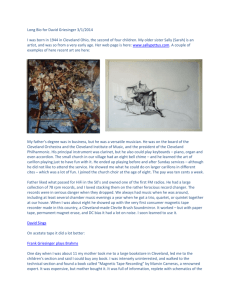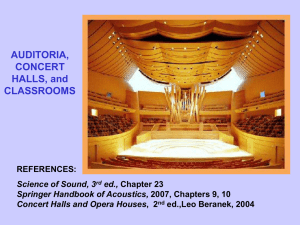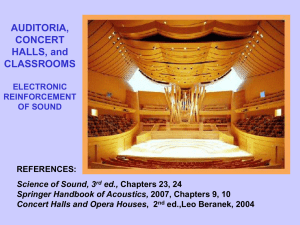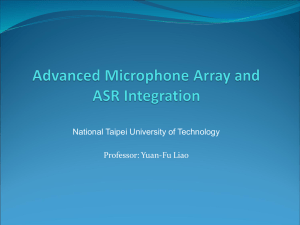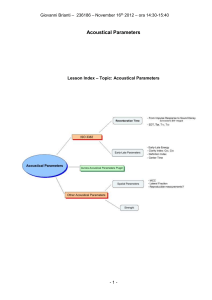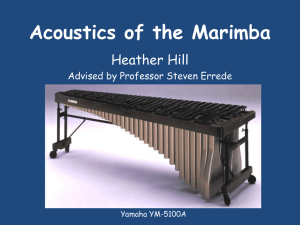RoomLab
advertisement
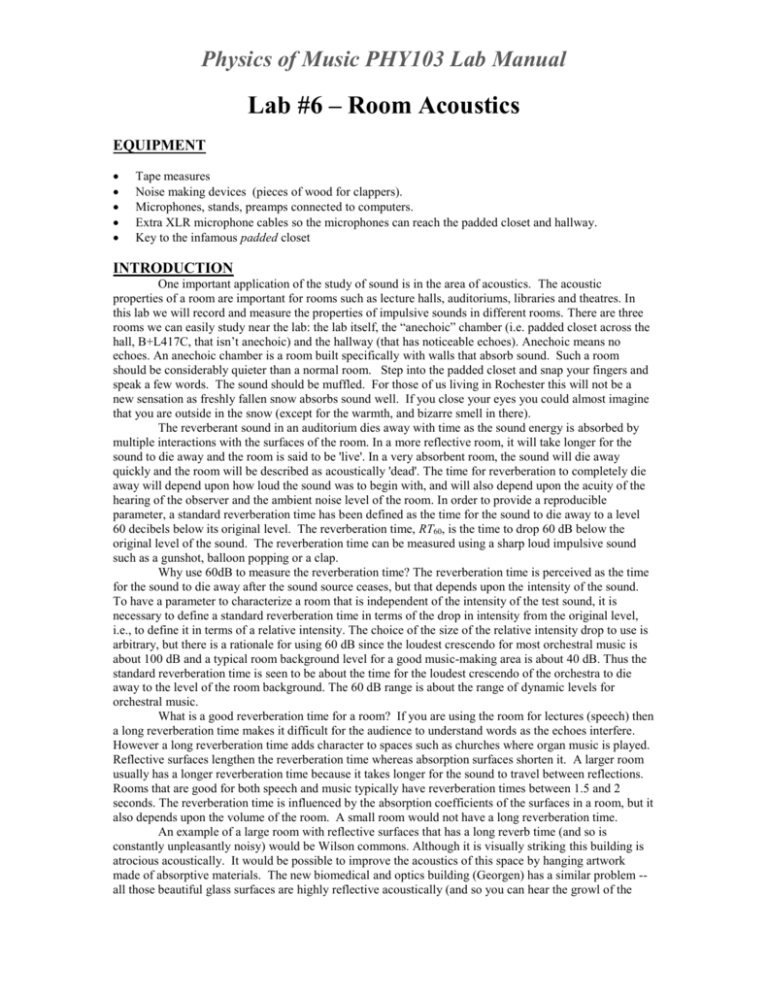
Physics of Music PHY103 Lab Manual Lab #6 – Room Acoustics EQUIPMENT Tape measures Noise making devices (pieces of wood for clappers). Microphones, stands, preamps connected to computers. Extra XLR microphone cables so the microphones can reach the padded closet and hallway. Key to the infamous padded closet INTRODUCTION One important application of the study of sound is in the area of acoustics. The acoustic properties of a room are important for rooms such as lecture halls, auditoriums, libraries and theatres. In this lab we will record and measure the properties of impulsive sounds in different rooms. There are three rooms we can easily study near the lab: the lab itself, the “anechoic” chamber (i.e. padded closet across the hall, B+L417C, that isn’t anechoic) and the hallway (that has noticeable echoes). Anechoic means no echoes. An anechoic chamber is a room built specifically with walls that absorb sound. Such a room should be considerably quieter than a normal room. Step into the padded closet and snap your fingers and speak a few words. The sound should be muffled. For those of us living in Rochester this will not be a new sensation as freshly fallen snow absorbs sound well. If you close your eyes you could almost imagine that you are outside in the snow (except for the warmth, and bizarre smell in there). The reverberant sound in an auditorium dies away with time as the sound energy is absorbed by multiple interactions with the surfaces of the room. In a more reflective room, it will take longer for the sound to die away and the room is said to be 'live'. In a very absorbent room, the sound will die away quickly and the room will be described as acoustically 'dead'. The time for reverberation to completely die away will depend upon how loud the sound was to begin with, and will also depend upon the acuity of the hearing of the observer and the ambient noise level of the room. In order to provide a reproducible parameter, a standard reverberation time has been defined as the time for the sound to die away to a level 60 decibels below its original level. The reverberation time, RT60, is the time to drop 60 dB below the original level of the sound. The reverberation time can be measured using a sharp loud impulsive sound such as a gunshot, balloon popping or a clap. Why use 60dB to measure the reverberation time? The reverberation time is perceived as the time for the sound to die away after the sound source ceases, but that depends upon the intensity of the sound. To have a parameter to characterize a room that is independent of the intensity of the test sound, it is necessary to define a standard reverberation time in terms of the drop in intensity from the original level, i.e., to define it in terms of a relative intensity. The choice of the size of the relative intensity drop to use is arbitrary, but there is a rationale for using 60 dB since the loudest crescendo for most orchestral music is about 100 dB and a typical room background level for a good music-making area is about 40 dB. Thus the standard reverberation time is seen to be about the time for the loudest crescendo of the orchestra to die away to the level of the room background. The 60 dB range is about the range of dynamic levels for orchestral music. What is a good reverberation time for a room? If you are using the room for lectures (speech) then a long reverberation time makes it difficult for the audience to understand words as the echoes interfere. However a long reverberation time adds character to spaces such as churches where organ music is played. Reflective surfaces lengthen the reverberation time whereas absorption surfaces shorten it. A larger room usually has a longer reverberation time because it takes longer for the sound to travel between reflections. Rooms that are good for both speech and music typically have reverberation times between 1.5 and 2 seconds. The reverberation time is influenced by the absorption coefficients of the surfaces in a room, but it also depends upon the volume of the room. A small room would not have a long reverberation time. An example of a large room with reflective surfaces that has a long reverb time (and so is constantly unpleasantly noisy) would be Wilson commons. Although it is visually striking this building is atrocious acoustically. It would be possible to improve the acoustics of this space by hanging artwork made of absorptive materials. The new biomedical and optics building (Georgen) has a similar problem -all those beautiful glass surfaces are highly reflective acoustically (and so you can hear the growl of the Physics of Music PHY103 Lab Manual espresso machine from the coffee shop everywhere in the building). It seems that some recently built buildings on campus are designed by architects who have neglected the acoustics of the spaces. I suspect that it might be possible to compensate for visually striking but acoustically reflective building materials with cleverly placed acoustic absorbers hidden in the ceilings behind the lights or boldly in the open as 3D structures on opaque walls. Predicting the reverberation time and Sabine’s formula. Sabine is credited with modeling the reverberation time with the simple relationship which is called the Sabine formula: RT60 (0.16sec/ m) V V (0.049sec/ ft) Se Se (Equation 1) This formula relates the reverberation time, RT60, to room volume and an effective area. You use the 0.16 sec/m coefficient if you are working in meters. You use the 0.049 sec/foot coefficient if you are working in ft. Here V is the volume of the room and Se is an effective area. The effective area is calculated as follows Se a1S1 a2 S 2 a3 S3 ... Here each area Si has an absorption coefficient ai. The effective area is a sum of areas, Si , each with its own absorption coefficient ai. These areas are the surfaces in the room (ceiling, walls, floor, seats, people, etc…). Another way to write the effective area is with a sum Se ai S i surfaces i Note you must put the areas (Si ) in the same units as the volume V (meter2 for area and meter3 for volume or ft2 for area and ft3 for volume). When a sound wave in a room strikes a surface, a certain fraction of it is absorbed, and a certain amount is transmitted into the surface. Both of these amounts are lost from the room, and the fractional loss is characterized by an absorption coefficient, a, which can take values between 0 and 1, 1 being a perfect absorber and 0 being a perfect reflector. Absorption coefficients are unitless. The absorption coefficient is the fraction of the power absorbed in one reflection. Absorption coefficients for some common materials are given below. The absorption coefficient of a surface can depend on the frequency of sound used to measure it. For example, carpet is quit absorptive at high frequencies but not at low frequencies. A perfectly absorptive room would have an effective area that is equal to the total surface area of its walls, ceiling and floor. A highly reflective room would have an effective area that is smaller than its total surface area. The Sabine formula works reasonably well for medium sized auditoriums but is not always an accurate predictor of the reverb time. The Sabine formula neglects air absorption, which can be significant for large auditoriums. It also tends to overestimate the reverberation times for enclosures with high absorption coefficients. The reverberation time is not the only important acoustic parameter of a concert hall or auditorium. Another measurement used to characterize a performance space is the based on the time of the first echo. Consider an impulsive sound produced on a stage and a position in the audience. One can measure the time between the arrival of the direct sound (travelling directly between source and audience position) and the arrival time of the first strong echo. Prior to renovation, the Eastman theatre, due to its very high ceiling was criticized because the first echo time in the center of the audience (high priced seats) was considered too long. During renovation, the volume of the theatre was reduced to improve the acoustics of the space. Other descriptive acoustical characteristics to consider are: Liveness – This just refers to the length of the reverberation time. The longer the reverberation time, the more “live” the room is. Intimacy – This refers to how close the performing group sounds to the listener. Fullness – This refers to the amount of reflected sound intensity relative to the intensity of the direct sound. The more reflected sound, the more fullness the room will have. Clarity – This is the opposite of fullness. In general, greater clarity implies a shorter reverberation time. Physics of Music PHY103 Lab Manual Warmth – This is obtained when the reverberation time for low-frequency sounds is somewhat greater than the reverberation time for high frequencies. Brilliance – This is the opposite of warmth. Texture – This refers to the time structure of the pattern in which the reflections reach the listener. The first reflection should quickly follow the direct sound. Blend – This refers to how well the mixing of sound occurs between all of the instruments playing. Ensemble – This refers to the ability of the members of the performing group to hear each other during the performance. The above terms can be used to describe a performance space and famous performance spaces can be ranked by performers and listeners. Researchers can measure and tabulate quantities such as reverb time, the time of the first echo and other quantities. Acoustic engineers have searched for relations between these measured quantities and the perceived quality of the performance space. These relations are now used to guide the design of performance spaces. Some problems in acoustical design are: Focusing of sound – This refers to the undesirable effect that occurs when sound is much louder at one point in the room than surrounding points in the room. Echoes – To obtain good texture, it is desirable to avoid any particularly large single echoes. Shadows – These are quiet areas that can be produced when there are large overhanging balconies or other structure jutting into the room. Resonances – It is necessary to separate the resonances of a speaker and the box enclosure of a tuned-port system to provide the best sound. External noise – This refers to noise coming from outside of the room. Double-valued reverberation time – If a recording of a musical event is played back in a room that it was not originally recorded in, this phenomenon can result. Absorption coefficients for common surfaces: Performers may request to rehearse in the concert hall prior to a performance. This gives them the feel of the concert hall and allows them to adjust the balance between instruments, dynamics and timing to Physics of Music PHY103 Lab Manual match the acoustic properties of the concert hall. However, rehearsals are often done in a concert hall that lacks a full audience and the audience itself can change the acoustic properties of the room. The role of the audience in affecting the acoustic properties of a room must be taken into account when designing a concert hall. A person or auditorium seat both contribute an effective area to the sum for Se. Effective areas for people and seats in auditoriums in sabins 120Hz 250Hz 500Hz 1000Hz 2000Hz 5000Hz Audience per 0.35 0.43 0.47 0.50 0.55 0.60 person in sabins Auditorium seat, solid un0.02 0.03 0.03 0.03 0.04 0.04 upholstered Auditorium seat, 0.3 0.3 0.3 0.3 0.35 0.35 upholstered A sabin is a unit of acoustic absorption equivalent to the absorption by a square foot of a surface that absorbs all incident sound. It is desirable to have similar acoustic properties in the room with and without the audience. The renovated Eastman-Kodak theatre has chairs that are designed to have effective area that is high and similar to that of a person sitting in the chair. The acoustic properties of the Eastman-Kodak theatre has been designed to be nearly independent of the size of the audience so that performers can rehearse in the hall and experience acoustics similar to those during the actual performance. PURPOSE The purpose of this lab is to explore the acoustics of different rooms. We can compare the characteristics of three rooms: the hallway, the lab (B+L403), and the padded closet (B+L417C) (aka “anechoic chamber” but its really not anechoic). Your lab group should use two of three of these rooms to measure sounds. You will measure the reverberation time of one of the rooms and compare your measured value to those estimated using Sabine’s formula. PROCEDURE A. Listening 1. By listening compare the characteristics of the three rooms: the hallway, the lab (B+L403), and the padded closet (B+L417C). Snap your fingers, carry out a conversation, sing, clap some boards together. B. Measuring the Reverberation Time 1. 2. 3. Go to one of the two rooms that your lab group has chosen to study. To record a quickly decaying sound you need to adjust the recording level so that the sound is not heavily saturated or clipped. Bring up Audition on your computer and make sure that the preamp is plugged in. You can look as the sound level by right clicking on the level meter (bottom of screen) and choosing “Meter Input Signal.” Make a loud clap with two pieces of wood. Check that the sound is strong and is not clipped. Adjust the preamp to a good level. Record a few claps. Play back your sound to hear what it sounds like. You want to hear the room echo not the clapper so you probably don’t want to clap near the microphone. Look at the waveform of your recorded claps. Expand the horizontal or time axis using the zoom button at the bottom of the screen (this looks like a little plus sign inside a circle). Take a look at the decay of the sound that you recorded. An example of a clap. Each large spike after the first one is an echo from different surfaces in the room. Large flat surfaces produce large strong echoes. Physics of Music PHY103 Lab Manual Figure from JBL Sound System Design Reference Manual 4. 5. 6. 7. Are there any particularly strong echoes in your room? Can you see them in the waveform of your recorded claps? Record a similar clap in another room and compare the two sound files. Chose a good recording of a clap and zoom in on it. Make sure the time format is set so that you can record the time with precision (to a precision of msecs or ms (milliseconds)). Click on “View” at the top of the program, select “Display Time Format” and choose “Decimal”. Write down the time that your clap starts. Measuring the loudness at a particular time. With a left click and drag, select a region of your waveform. Click on “Window” at the top, chose “Selection/View”. This window will show you the beginning and end of your selected time. Write down the start and end times of your selected region. You can edit these times by clicking on them if you would like to set particular values. A selected region of the waveform. The sharp spike at the beginning is the direct sound. The rest is likely reverberant. Physics of Music PHY103 Lab Manual 8. Bring up the amplitude statistics window. Click on “Window” then select “Amplitude Statistics”. If you click on the “Scan Selection” box in this window, the statistics of the sound file in your selected time will be computed. Using RMS settings you can set a width of a bunch of time boxes for computing statistics within your Selection (in white). In each of these little time boxes an amplitude will be computed (from the integrated root mean square of that within the time box when you click the Scan Selection Button). The Total RMS amplitude is that computed across your entire time selection. The Average RMS Amplitude is the average of those values computed for each of the smaller time boxes. Perceived Loudness differs from Loudness as the value is more strongly dependent on mid-frequency ranges (where the ear is most sensitive). Probably the number we would like to use is the Average RMS Amplitude. These numbers are given in dB which is decibels or or 10 log10 (Power). 9. Click on the RMS settings box in the amplitude statistics window and set the Window Width to something smaller than your selection size, like 5 or 10 ms (milliseconds). Then go back to the “General” section of the Amplitude Statistics Window and recompute the amplitude statistics by clicking on “Scan Selection”. 10. Record the Average RMS Amplitude at different times after the onset of the clap (with selection windows larger than 10ms). Make about 7-10 measurements at different times (after the Physics of Music PHY103 Lab Manual beginning of the clap). Write down the Average RMS Amplitudes, the start and end times for your 7-19 measurements. 11. Bring up the frequency analysis window. Using the hold buttons see if you can determine whether the high frequencies decay faster or slower than the low frequencies. First select a time just after the beginning of the clap. Hold that spectrum. Then select a later time. You should be able to see both spectra simultaneously so you can compare their slopes. The figure below shows the spectrum of a clap at two different times. The green line is the spectrum at a later time than the red line. The higher frequencies decay more rapidly than the lower frequencies. 12. ANALYSYS: Plot dB level (your Average RMS Amplitude) vs time from the beginning of the clap (mid time of your selection window subtracted by the start of your clap). You should see points that lie along a line. If you don’t see this consider making your measurements in a different way and redoing your measurements. It may be that the first point is higher than you expect (possibly because you recorded very close to where you clapped) – if so consider ignoring it, but mentioning that you are doing so in your analysis. If your plot has a series of points in a line then the power is decaying exponentially in time. Since dB is the logarithm of the power we expect that an exponential drop in power would be equivalent to a line on a plot of dB vs time. Mark a line that lies on top of your plotted data points. The slope of this line is related to the exponential decay rate of the sound and the reverberation time. A line that is very shallow corresponds to a sound that takes a long time to decay so the reverb time is long. A line that is steeply droping corresponds to a sound that decays rapidly and so the reverb time is short. 13. It is impractical to directly measure RT60 or how long it takes to drop 60 dB below the loudest level. This would correspond to a drop of a factor of a million in the power of the noise. What prevents us from measuring the sound level over such a large range? We can’t measure noise fainter than the ambient background noise. Also the analog to digital converter on the sound card in the computer doesn’t have enough bits to cover this large a dynamic range. How are we going to calculate RT60 if we can’t measure the sound when it is 60 dB fainter? We can assume that the decay of the sound follows a line when plotted as dB vs time. Using your plot of dB vs time, extend your line and estimate how long it would take for your sound to decay to 60dB below that of the loudest part. For example you could measure how long it takes the power to drop by 20 dB and multiply that time by 3 – assuming that it would take three times as long to drop another 40dB. This time is then an estimate for the reverberation time or RT60. This technique is called extrapolation. Extrapolation is not accurate if done over a large range but is sometimes necessary to make an estimate. C. Predicting the reverberation time using Sabine’s formula. 1. 2. Using the various measuring devices, estimate the volume of the room. Note: floor tiles in the US tend to be 1ft square. Estimate the surface area of the different absorbing materials in the room. It’s difficult to do this for the lab because it is so cluttered. Physics of Music PHY103 Lab Manual 3. 4. Estimate the affective area of your room, Ae, using absorption coefficients listed above. If a material in your room is not found on the chart, make a guess at what the absorption coefficient is based on what material it is most like on the list. Roughly predict the reverberation time using Sabine’s formula. Does your predicted RT60 agree with the one you measured? A clap has a fairly flat spectrum (both high frequency and low frequency components, as seen in the above spectrum). It is hard to do this comparison exactly as absorption coefficients depend on frequency. What other effects might account for any difference between your predicted and measured value for the reverberation time? Lab Report Requirements Your name and collaborators. An abstract summarizing your major findings. A plot of decibel vs time showing the rate that sound decays in a room. Your estimate based on this plot for the reverberation time of that room. A discussion of whether your reverberation time measured from the plot agreed with what you predicted using Sabine’s formula. Notes: We always seem to predict reverb times using Sabine’s formula that are quite different than the ones we measure from the decay timescale. I have not figured out why.

